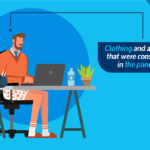- An analysis including 13.5 million customers shows that the boom of e-commerce throughout the pandemic will not remain in 2021. However, electronic commerce will still be a growing trend.
- 60% of customers consider factors such as safety and lower risk of infection while shopping. This will definitely characterize post-Covid consumption.
- In the search for larger surfaces, retailers need to innovate online and in physical stores. The competition must improve the customer experience.
Keywords: e-commerce, electronic commerce, customers, customer experience
VIPO GROUP
It is undeniable that the coronavirus significantly drove electronic commerce specially during the stricter months of confinement. However, a study from Caixa Bank (Spain) shows that this trend will be more moderate in 2021.
This conclusion was based on the analysis of purchases with 13.5 million bank cards. The company compared their usage during the months of May and September both in 2019 and 2020. The results are quite interesting.
Initally, the rise of e-commerce was confirmed in May with spending increased by 6% going from 13.8% in May 2019 to 19.8% in May 2020. Furthermore, 47% of cards were only used in physical stores in May 2019, and this number dropped to 40% in the same month this year.
Analysts state that these variations were caused by the confinement forced on the population. E-commerce also worked as a lifesaver for many businesses. Nonetheless, only 6.5% of Spanish SMEs enable purchases via electronic commerce. This creates a barrier for consumers that wish to buy online from their prefered brands.
A more ‘normal’ September
The months of September show a relative return to the status quo. Comparing September 2019 and September 2020 leads to conclude that 3% less people bought only in physical stores this year. Additionally, customers who spend more than half their budget online only rose by 1.7%.
They stated that “September (2020) exhibited a growth in e-commerce similar to the one that we have seen in previous years”. Researchers analyzed that specific month since there was relative control over the pandemic.
In conclusion, although electronic commerce reached a higher market penetration during the confinement period, it does not imply that it will increase in 2021.
Post-Covid consumption
Companies and stores hit by the pandemic have been forced to migrate online to keep their businesses afloat. Hence, they need to apply solid strategies in terms of marketing and digital channels as well as improving in e-commerce. Many companies suffer a transformation process and require investment and consulting. Furthermore, physical stores will still exist and need to be strengthened in the face of coronavirus.
“Knowing and learning the evolution of the consumer is essential. We need to distinguish which changes in their behavior are structural and which are circumstancial”, as stated by Enrique Porta, from the KPMG firm.
According to data from KPMG, the quality / price ratio is the most decisive factor during a purchase for 6 out of 10 consumers. This was revealed by a poll comprising 12.300 customers globally. Another key factor comes into place: the personal safety of the customer. The current pandemic has made this aspect influential for 60% of current purchases.
Therefore, stores not only need to be safe, but must also be branded as safe. The strategy of protected spaces must be applied on the long term, as Porta adds. “This means insisting on limiting the number of people within stores and social distancing. Technology-based innovation to redefine customer experience”, as he concludes.
Technology sets the tone during post-Covid
If something is clear is that technology has been the leading enabler of businesses. In fact, it has been the cornerstone of the continuity of human life. Consumers have developed great sensitivity towards brands that adopt new innovation processes, particulary those that offer safety, comfort and customization.
Physical stores must seek tools to meet customer demands. Resources must be well used whilst offering a unique experience.
VIPO GROUP offers an innovative option for physical stores. Thanks to the technology, customers can access interactive screens that help them find more suitable clothing items. After introducing their data and interests, an artificial intelligence module processes them and hands out options. This allows the buyer to determine in which areas of the store they can find the listed clothes. The customer experience is thus improved contributing to his loyalty to the brand.
On the other end, the adoption of this technology allows stores to gather data from the multiple screen-based interactions. The information can be then used to improve sales and promotion strategies. Furthermore, the control of inventory is enhanced and resources are allocated with solid planning.
In conclusion, 2021 will be a year of challenges. Digital channels and electronic commerce will need to evolve to attract customers and boost sales. Consumers still want to visit physical stores as long as they are safe. This requires more commitment and effort from store owners: they must do everything in their power to turn their facilities into reliable spaces, where a unique customer experience can be guaranteed.
Reference links:
- E-commerce growth during the pandemic: myth o reality? https://bit.ly/3lZNQoR
- Consumer in postCovid-19 times https://bit.ly/3gDnzfb
- Three condintions to have a great user experience in uncertain times. https://bit.ly/36XZtbx
CRM TEAM
VIPO Group





